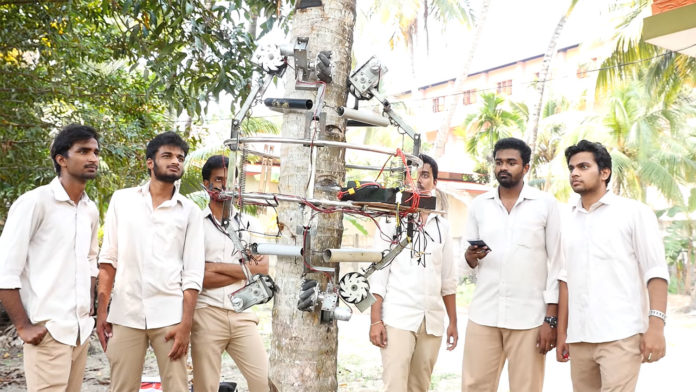Harvesting coconuts by climbing trees roughly 15 meters high is quite a risky task. Also, as the population is increasingly moving towards educational jobs, they don’t want to take up the risky job of climbing coconut trees.
The shortage of human coconut tree climbers to harvest coconuts in India and other developing countries has led researchers to develop a robot that helps coconut farmers in harvesting. It could one day reduce the need for human harvesters to take such a risk.
The robot, named Amaran, is an unmanned wireless robotic coconut tree climber and harvester, which was created by a team led by Rajesh Kannan Megalingam, an assistant professor at Amrita Vishwa Vidyapeetham University, in South India. They have been working on Amaran since 2014.
The tree-climbing Amaran is comprised of a harvester with a distinctive robotic arm (RA) and a cutter, which can be attached to a ring-shaped frame that can be fastened to the base coconut tree of any thickness. It has a control module, motor drivers, a power control unit, and a wireless communication interface. Eight wheels allow it to move up and down the tree, as well as rotate around the trunk.
Amaran is not an expert in jumping over obstacles or making decisions about the movement independently; it is controlled by a person on the ground, who can use wireless joystick HCI or smartphone-based Aroha App to guide the robot’s movements.
Once dispositioned in the vicinity of the coconut bunch, a robotic arm with 4 degrees of freedom is commanded to harvest the coconuts. Amaran then cuts the stem of the bunch attached to the tree, allowing the coconuts to fall to the ground. If the main battery of the robot is discharged, the backup unit is activated so that the robot can return to the ground.
The robot was tested in two conditions: in a laboratory on a three-meter section of a palm tree and on real trees with a height of 6.2 to 15.2 meters. During laboratory tests, the angle of the inclination of the barrel changed from 0 to 30 degrees. Tests have shown that the robot ascends to the end of the three-meter barrel in an average of 13 seconds, and descends in about eight and a half.
In real tests, the authors compared their development with a real collector. He climbed a 9.6-meter palm tree five times for bunches of coconuts and, taking into account the breaks, spent a total of 59.2 minutes on it. The robot spends, on average, 21.9 minutes processing one bunch of coconuts (of which 14 minutes is spent on preparation at the base of the tree).
However, it is also observed that human coconut harvesters work faster than the robot. But Amaran could work for longer. It can harvest more trees on a given day if the operator does not get tired.
